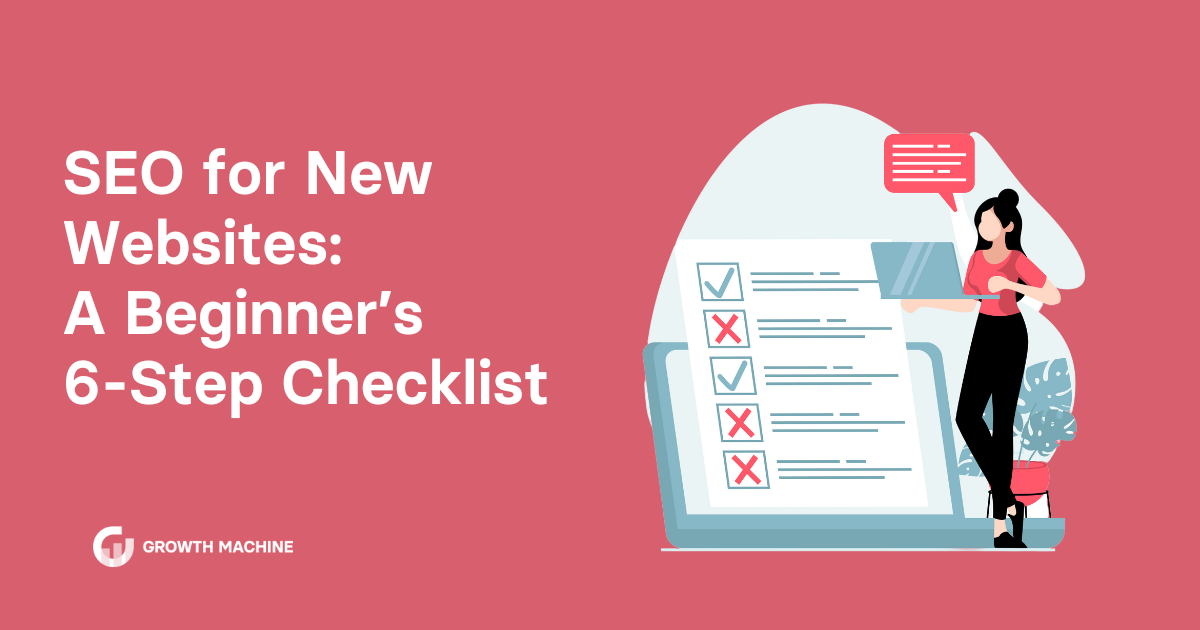SEO for New Websites: A Beginner’s 6-Step Checklist
A brand-new website is a fresh start for your business. While you might be eager to populate your pages with content and start generating traffic, you need to consider search engine optimization (SEO) for your new website.
SEO is the smartest strategy for boosting your new website’s authority and traffic. Succeeding in SEO is a long journey, but following some best practices can help you create an effective website that turns more heads as quickly as possible.
Let’s look at why you need SEO on every page of your site, plus six steps to help you do effective SEO for a new website.
Why Every New Website Needs SEO
From choosing a domain name to designing your web pages, you’ve already put in a lot of work to build your website. But you aren’t done yet. When it’s time to populate your website with content, you need to write that content with SEO in mind.
SEO might seem like an extra step, but it’s crucial for every website. A solid SEO checklist helps you:
- Rank higher in Google: SEO is crucial for online visibility. Search engine algorithms have a big impact on your rankings, so you need a website that plays nicely with how search engine bots categorize information. The more you optimize your site to appeal to search engines, the higher you’ll likely show up in search results — and the more people will see your site.
- Become an authority: SEO can help you build credibility. With backlinks and quality content, you can make a name for yourself as a trusted expert. Over time, people will come to trust your brand, all thanks to strong SEO.
- Improve your user experience: What’s good for users is good for search engines, too. Search engines try to direct users to the best possible answers to their questions. By optimizing your website for search engines, you also make your site better for users. And when users have a better experience on your site, they’re more likely to stick around and see what you have to offer.
- Save money: SEO is a long-term digital marketing strategy. You likely won’t see an immediate payoff, but it’s still one of the most cost-effective ways to generate traffic to your site. If you’re bootstrapping this new website, SEO can help you generate more quality traffic without spending a dime on expensive ads.
How to Do SEO for a New Website: 6 SEO Tips
A new website is a blank slate. Following proper SEO practices starts your website on the right foot and generates more quality traffic. SEO might sound technical, but you don’t need to be an expert at search engines. All you need is a solid plan to optimize your website.
If you aren’t sure where to start, follow this six-step plan to do SEO for a new website.
1. Start With Research
Before you write any content for your website, it’s best to do a little information-gathering first. Understanding the lay of the land will help you differentiate your website and solve your users’ problems more effectively. If you haven’t already, research your:
- Market: Whether you’re an e-commerce website or a small boutique with a blog, it’s important to know the general market you’re working with. For example, is this a competitive industry? If so, that will have a direct impact on your target keywords and content posting frequency.
- Competitors: You shouldn’t copy everyone else, but it’s still good to understand what other websites are saying. Look for your top five competitors. What are they doing well on their blog? Where are they falling short? See how you can surpass your competitors with content that solves tangible problems for your target audience.
- Audience: Who is your target audience? What do they need to know when they visit your website? Create buyer personas to better understand your target users. By understanding your audience’s needs, you can create better content and experiences that solve their problems. What’s good for users is good for search engines, so catering to your target audience’s needs will boost both engagement and your SEO rankings — it’s a win-win.
2. Conduct Keyword Research
Keywords are words or phrases that searchers use to find content on search engines. For example, someone might type in the keyword phrase “Ice cream near me” if they want to find a local ice cream shop.
Search engine crawlers look for keywords on your website to determine if you offer the most relevant answer for each person’s search query. Based on keywords — as well as many other factors — the search engines then decide where your website lands on the search engine results page (SERP).
This is why keywords are so important. Using the right mix of search terms on your new website can help you show up for the most relevant users.
For a new website, you’ll need to conduct keyword research. Since you’re likely competing against better-established websites, it’s best to go for long-tail keywords for your new website. For example, instead of targeting the phrase “auto shop,” you should go after a more specific long-tail phrase like “Houston auto shop with free brake checks.” Other sites are less likely to target these hyper-specific phrases, so you’re likely to gain more traction by targeting niche phrases at first.
Once you have your list of keywords, you need to incorporate them throughout your website. The key is to do this in a way that still adds value to your readers. A landing page listing a jumble of word soup doesn’t offer value to your site visitors, so you’ll need to weave these keywords into real, high-quality content.
3. Create Quality Content
Content creation is the backbone of SEO for new websites. When you create new content on your website, like pages or blogs, you’re increasing your chances of showing up in search. This is why so many businesses invest in content marketing: The goal is to create content that attracts organic traffic through clever keyword targeting.
Try to post helpful, long-form content at least once a week to your new website. Long-form content takes more work to produce, but search engines tend to prefer longer content in the 1,200- to 2,500-word range.
Creating content requires hours of research, solid writing chops, and an eye for SEO. If you need high-authority content, consider working with an SEO-focused agency like Growth Machine.
Once you have enough content on your website, use internal linking to enhance your website’s structure and navigation. Internal links connect relevant pages of your website together, so users always have another page to explore for more information. This will keep searchers on your site longer, as well as give search engines a better idea of your site’s structure.
4. Optimize On-Page SEO and Technical SEO
This step is the most technical part of SEO, but it’s crucial to gaining traction in the SERPs. On-page SEO is the process of tweaking the back end of your website to be more appealing to search engines.
This typically comes down to:
- Optimizing meta data: Drop relevant keywords into your title tags, page titles, image alt text, meta descriptions, and headers to improve visibility.
- Revamping your site structure: Make sure your URLs have a clear hierarchy, and try to keep your URLs as short and simple as possible.
- Encouraging indexing: You can encourage search engines to index your site by submitting an XML sitemap. You can also specify which pages you don’t want search engines to crawl by editing your robots.txt file.
- Improving site speed: Work with your developer to minify code, use lazy load on images, and compress large files to speed up your site.
5. Invest in Off-Page SEO
Once you’ve optimized your on-page SEO, it’s time to look at off-page SEO. Off-page ranking factors tell search engines that your website is reputable. After all, the more websites that link to you, the more useful your website’s content likely is.
Backlinks are the backbone of off-page SEO. There are several linkbuilding strategies you can use, but the most effective ways to gain backlinks are:
- Creating absurdly good content, like white papers or original research, that everyone in your niche wants to link to.
- Writing guest blogs on other industry sites.
- Conducting cold email outreach asking for relevant backlinks.
- Leveraging social media like Facebook, LinkedIn, and Twitter to build buzz about your brand.
- Networking with other professionals in your industry.
- Trying a reputable linkbuilding service like Growth Machine that manages topic and keyword research, publishes content, and performs backlink outreach.
6. Use SEO Tools to Monitor Performance
SEO requires a lot of testing and experimentation. You need the right mix of tools to understand whether your SEO efforts are working, or if you need to rethink how you do SEO for a new website.
At a minimum, rely on these trusted SEO tools:
- Google Search Console: This free tool from Google helps you understand your website’s health and performance.
- Google Analytics: This free analytics platform offers a deep dive into your site’s traffic, bounce rate, and a lot more.
- Semrush: Need help with keyword research? Semrush is a popular tool for generating relevant keywords for your new website.
- Yoast: If you have a WordPress website, this free SEO plugin will help you write SEO-focused content that gets more results.
Start on the Right Foot: Boost Your New Website’s SEO
Building a new site can feel intimidating, but a solid SEO strategy can help you rank better in organic search. Whether you’re a total beginner or an SEO expert, follow these six best practices to build an SEO-friendly site that turns more heads:
- Research first
- Build a keyword list
- Create quality content
- Optimize on-page SEO
- Invest in off-page SEO
- Use SEO tools
If you’re overwhelmed at the thought of DIY SEO, we’ve got you covered. Growth Machine helps businesses understand their audience, create a search engine strategy, and execute that strategy with weekly optimized articles written and published to your site for you.
Let’s start your new website on the right foot. Chat with Growth Machine to overhaul your website’s SEO.







